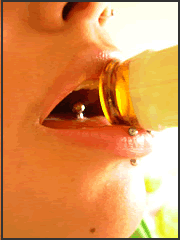As if raising teenagers wasn’t already difficult enough, parents are constantly barraged with information about the best way to deal with their teens. In addition to there being a copious amount of information available, it does not help that much of it is contradictory. For example, when it comes to using drugs and alcohol, parents are warned that those substances are dangerous and young adolescents should definitely not be exposed to them. On the other hand, parents are also informed that it is normal for teenagers to experiment with illicit substances and that the majority of them will not end up as drug addicts. So what’s a parent to do? Is there a certain time period when teenagers can experiment with drugs and alcohol and not worry about ruining their lives? Is it only the “bad kids” that start drinking early who are at risk for becoming unhealthy adults?
Psychologist Candice Odgers from the University of California, Irvine along with her colleagues, were interested in those questions and wanted to see if being exposed early-on (before the age of 15) to drugs and alcohol would result in poor health outcomes in adulthood. Over 1000 three-year- old children were enrolled in this study and numerous follow-up assessments were made over the next 30 years. When the children were between 7 and 13, their parents and teachers reported their behavioral problems (including fighting, bullying and telling lies). When the study members were 13 and 15 years old, they were asked about their frequency of exposure to drugs and alcohol during the past year; this enabled the researchers to identify those adolescents who were early users of illicit substances. When the study members were 32 years old, researchers assessed if they had any substance abuse disorders, if they had tested positive for sexually transmitted diseases (STDs), the number of criminal convictions that they had and also in females, they examined if they had early pregnancies (i.e. before the age of 21).
The results of the current study, published in the October issue of Psychological Science, a journal of the Association for Psychological Science, found that adolescents who were exposed to drugs and alcohol before the age of 15 were 2 to 3 times more likely to become dependent on substances, contract STDs, drop out of school and have criminal records. In addition, teen pregnancy rates were higher among females who used drugs and alcohol before the age of 15 compared to those who did not use illicit substances at a young age. Interestingly, the researchers discovered that 50% of the adolescents who were exposed to drugs and alcohol prior to age 15 had no prior history of negative behavioral problems.
The researchers found that alcohol was the substance that was most commonly used by teenagers; however, using a variety of substances caused a greater risk of poor health outcomes in adulthood. When the researchers analyzed the adult data, they found that early exposure to drugs and alcohol resulted in a greater risk of abusing substances, contracting STDs and having criminal records even among adolescents who did not have adverse behavioral problems as children. Furthermore, in adults who had negative behavioral problems as children, early exposure to drugs and alcohol greatly exacerbated their risk for developing substance abuse, school failure and criminal convictions.
“Findings from this study are consistent with the message that early substance use leads to significant problems in adolescents’ future lives (that drugs are bad for kids) versus the alternative message that young adolescents with history of problems are just more likely to use drugs early and experience poor outcomes (that bad kids do drugs),” Odgers commented, “Even adolescents with no prior history of behavioral problems or family history of substance abuse problems were at risk for poor health outcomes if they used substances prior to age 15. Universal interventions are required to ensure that all children — not only those entering early adolescence on an at-risk trajectory — receive an adequate dose of prevention.”

